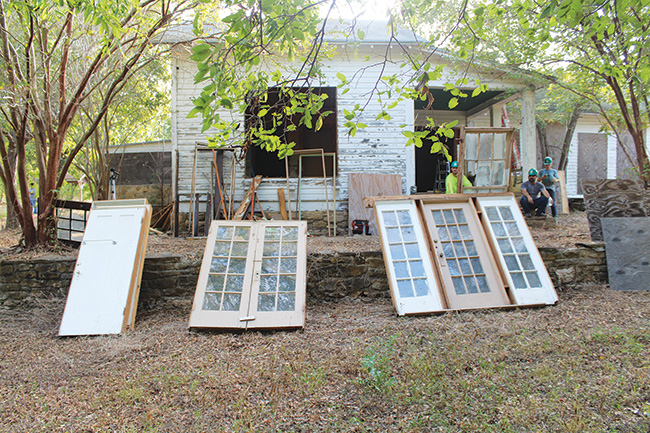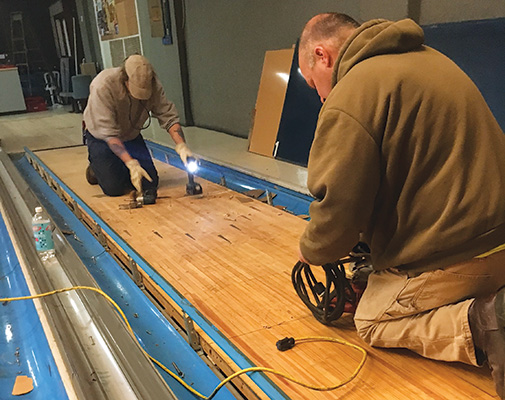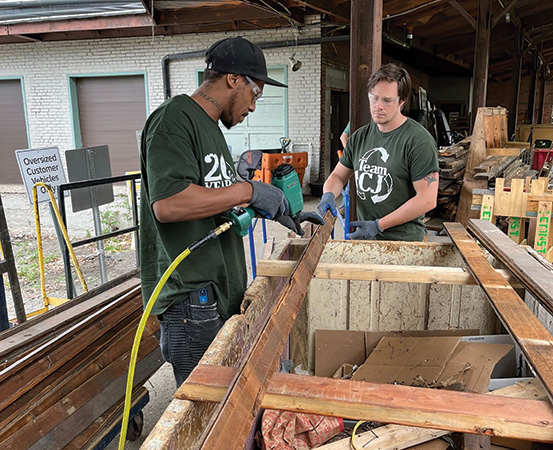Not all buildings are candidates for deconstruction or mass material recycling, but many are—first we need the will to put systems and infrastructure in place to do it.
By Mike Gable
Prioritizing reuse, before recycling, of construction materials and building components has many environmental, economic, social, and cultural benefits. Among the most significant are: 1) saves energy by decreasing the consumption of natural resources to produce new materials, 2) reduces landfill waste that contaminates groundwater and contributes to greenhouse gas emissions, 3) decreases costs associated with disposal, 4) significantly reduces the embodied carbon impact of construction projects, and 5) with the proper partnerships can provide skills training and job creation. Not reusing or recycling construction materials is a missed opportunity to make productive use of what will otherwise become waste. Construction of buildings and the extraction of material used in buildings is one of the three largest consumers of the planet’s resources. With only 20 to 30 percent of those resources being recycled, and to a lesser extent reused, it is imperative we create a different set of lenses to assess a building’s lifecycle and value.

A Systemic Shift
According to the EPA, construction and demolition produces 169 million tons of debris annually that is landfilled, 90 percent of which comes from demolition. We need to begin a systemic shift from a linear take-make-use-dispose based economy to a reuse economy, based on a circular model where we keep materials in use for as long as possible. Practiced at scale, this could address supply chain issues and support a more regionally oriented economy.
Where to start? First, recognize and prioritize the economic opportunity present in retrofitting, renovating, and adapting the existing building stock in your region, which already makes up more than 90 percent of the building stock needed by 2025. If buildings cannot be adaptively reused, then at a minimum, identify existing building material that can be reused through the practice of deconstruction.
Sustainability oriented cities and municipalities around the country are taking the demolition of existing buildings more seriously by enacting deconstruction policies, ordinances, grant incentives, and best practice initiatives in their regions. Deconstruction, also referred to as “construction in reverse” or “unbuilding”, is the process of removing a building by selective disassembly of structural and non-structural building components.
Several U.S. cities already have deconstruction ordinances in place. In July 2016, Portland, OR became the first city in the country to ensure that valuable materials are salvaged for reuse instead of crushed and landfilled. Portland City Council adopted an ordinance, which required certain projects seeking a demolition permit to be fully deconstructed as opposed to mechanically demolished. Based on the success of the initial ordinance, Portland City Council enacted an amendment in January 2020, which raised the year-built threshold from 1916 in the original ordinance to 1940. All single-dwelling structures (houses and duplexes) in all zones are subject to the Deconstruction Ordinance if the structure was built in 1940 or earlier, or if the structure is designated as a historic resource subject to the demolition review. Furthering its commitment to diverting building materials from landfills, the City of Portland has partnered with ReBuilding Center, an area climate justice non-profit, to provide donated construction materials for free to low-income property owners who need help bringing their homes and businesses into compliance with building codes.
Milwaukee, WI’s deconstruction ordinance went into effect January 2018 and covers structures built in 1929 or earlier, designated historic structures, and structures in historic districts. The requirements state that those structures must be deconstructed rather than demolished to maximize salvageable building materials.
As of July 2020, the City of Palo Alto, CA no longer allows building demolition. Deconstruction, reuse, and source separation are required. Despite Palo Alto’s already high recycling rate for construction projects, approximately 44 percent of what Palo Alto sends to the landfill comes from construction and demolition projects. The new requirements will prevent tons of valuable material from demolished homes from being landfilled, conserving natural resources, reducing greenhouse gas emissions, and encouraging Zero Waste.

Photos courtesy of Construction Junction.
In 2021 after considering a deconstruction ordinance for some time and after intense debate over the demolition policies, Boise, ID approved a deconstruction ordinance that has also linked to its demolition permit process. The city has implemented a Deconstruction and Demolition Material and Waste Management Plan to provide contractors with a guide to identify materials diverted from the landfill as waste to be recycled or reused. As part of the process for deconstruction or demolition permits, applicants must send e-mail notice with photos of available materials to reuse stores and companies on the city’s list and coordinate the salvage of the building materials.
Materials Reuse Policies
Several other cities are currently working toward deconstruction ordinances, proposing materials reuse policy. In Baltimore, MD, reuse advocates and government leaders have drafted the Recovering Baltimore’s Underused Inventory of Lots and Dwellings Act (the REBUILD Act.) The Bill, which is anticipated to be heard by City Council later this year, calls for a total of $4 million annually to support deconstruction efforts through workers training, required deconstruction of houses built before 1970, as well as any government buildings, and includes a specific list of onsite materials management practices to make recovery of materials more efficient and reduce the need for illegal roadside dumping in Baltimore’s communities.
In San Antonio, TX, the City’s Office of Historic Preservation launched a Deconstruction & Circular Economy Program in 2018. In addition to developing a draft deconstruction ordinance, which is slated for City Council action in early fall 2022, a priority for San Antonio’s program is directing reclaimed materials into the rehabilitation of existing affordable housing stock of a similar construction era. To that effect, in 2022, the City launched the Material Innovation Center at Port San Antonio, a former Air Force Base and current technology innovation campus, to serve as a trade workforce training site, community tool library, and the “last stop before the landfill” for building materials. The program has placed a special focus on how deconstruction and material reuse can advance the City’s affordable housing, workforce development, heritage conservation, equity, and climate action goals, as well as national and international decarbonization targets.
In the City of Ithaca, NY the CR0WD Network is a partnership between the Cornell University Circular Construction Lab, the Cornell Just Places Lab, Finger Lakes ReUse, Historic Ithaca, the Preservation Association of Central New York, the Susan Christopherson Center for Community Planning, and representatives from additional organizations. They are in the process of proposing a deconstruction ordinance.
Other cities and states have construction material bans and reuse requirements. In Seattle, WA, green building incentives for new construction also focus on the demolition of existing houses by requiring the full or partial deconstruction consisting of at least 1,000 board feet of wood material, using at least 500 board feet of salvaged material in the new construction, retaining an existing structure as part of the proposed development, or relocating a structure.
Additionally, all demolitions in the city must work with a building material salvage company to assess recoverable materials prior to permit issuance. There are other options not related to reuse for demolitions, but over the last year the reuse options are gaining popularity.
Outside of Seattle city limits, in King County, WA and surrounding areas, the Regional Code Collaboration (RCC) and partners have worked together to develop construction and demolition materials management related codes that may be adopted by interested local jurisdictions.

These codes encourage the highest and best use of material through recycling and salvage efforts by proposing requirements for the submittal of a salvage assessment and waste diversion report, proper removal of lead siding/exterior elements, and deconstruction instead of demolition for residential buildings built prior to 1940. Over the next year, they are working toward putting the infrastructure in place for the training and certification of third-party certified salvage professionals and deconstruction contractors.
Building Market Demand
In the absence of a formal ordinance, many other cities create programs to build momentum for deconstruction and reuse, to grow community support, and to help build market demand for salvaged and used building materials.
For example, in Pittsburgh, PA where there are more than 1,700 condemned as uninhabitable buildings, an executive order was issued in April 2021 by then Mayor William Peduto, charging the City of Pittsburgh to develop a unified City-led deconstruction policy and establish a city-led pilot program using deconstruction methods on City-owned condemned properties. The region’s reuse non-profit Construction Junction is presently working with the city to evaluate which condemned buildings contain reusable materials. Construction Junction believes all commercial and residential buildings in Pittsburgh that are to be demolished or significantly renovated should be required to have a reuse assessment to determine a suitable “next use.” This should be far more comprehensive than just recycling metals.
The City of Atlanta partnered with Lifecycle Building Center to advance deconstruction as a tool for workforce development. In November 2019, the Lifecycle Building Center was awarded a $50,000 Sustainable Materials Management grant from the Environmental Protection Agency to fund a deconstruction pilot training program and the creation of a Reuse for Communities Toolkit. Build Reuse, a nationwide nonprofit, will use the toolkit to educate communities across the country and develop a network of deconstruction and reclamation with the goal of increasing the job market around reuse.
San Francisco has partnered with climate tech company Rheaply, to build an online exchange for surplus and salvaged building products. The project, funded through Carbon Neutral Cities Alliance (CNCA) Game Changer Fund and set to launch late 2022, will enable businesses in the greater Bay Area to access surplus and salvaged resources at cost-effective rates. For small businesses and nonprofits, the time and cost savings of being able to access these reusable materials, rather than having to buy new, full-price items could be highly impactful.
Hennepin County, MN offers Building Reuse Grants for projects that salvage, reuse, and recycle building materials instead of mechanical demolition in the destruction, alteration, or renovation of a building. Funding may be provided to a variety of building projects including deconstruction of residential properties built prior to 1970; deconstruction of commercial properties, including multi-family apartment buildings over four units; structural moves that physically relocate a building to another location, (avoiding demolition waste while preserving the cultural and historical integrity of the building); and used building material installation for remodel, renovation, and new construction projects that incorporate used building materials into their designs. In the small Pennsylvania cities of Aliquippa, Midland, Beaver Falls, and neighborhoods in Pittsburgh, there is an effort using deconstruction to mine the troublingly abundant supply of abandoned houses for reusable building components (doors, fixtures, etc.) and structural materials (brick, framing lumber, etc.) Two nonprofits, The Reclaim Project and Construction Junction are working with government, workforce development entities, private businesses, and other environmental nonprofits, to maximize the material value recovered from these properties. Both deconstruction pilot projects are only possible because of the partnerships with municipalities (and NGOs). Government commitment to deconstruction serves to create the robust job pipelines necessary to support job trainees as well as produce more predictable volumes of reclaimed materials.
Reinvestment
Not all buildings are candidates for deconstruction or mass material recycling, but many are—first we need the will to put systems and infrastructure in place to do it. In addition to
recovering reusable materials, we need to go a step further to incentivize sustainable design and material choices in the buildings that replace demolished structures. New buildings can be designed for deconstruction and incorporation of existing building components, making the new structure a “material bank” as well as meeting its functional and aesthetic goals.
It is a given when presenting “an extra step” or added labor (reuse is labor intensive) or working outside the well-established waste disposal infrastructure (that has often benefitted from
subsidies) it translates into initial higher costs, but proponents believe this is an appropriate response to a system that has yet to consider a full accounting of what unsustainable resource extraction actually costs.
Construction materials reuse is a reinvestment in our neighborhoods. Let us move that forward to wider application and build towards more sustainable building practices that benefit our
communities, employment, the environment, and our economy. | WA
Mike Gable is the Executive Director of Construction Junction, Western Pennsylvania’s first nonprofit organization to collect and sell used and surplus building materials. He is also President of Build Reuse, a nonprofit organization established in 1994 to encourage the recovery, reuse, and recycling of building materials in the U.S.. Build Reuse is also committed to developing social investment and workforce development programs in the deconstruction industry.
Build Reuse will be presenting its annual Deconstruction + Reuse Conference, the only North American conference focused explicitly on reuse in the built environment, on October 18 – 20, 2022 (Virtual.) For more information, visit buildreuse.org.
